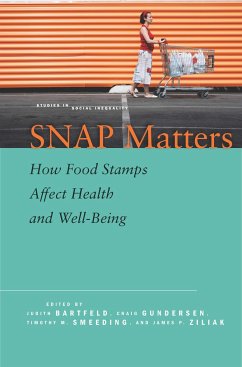Snap Matters
How Food Stamps Affect Health and Well-Being
Herausgeber: Bartfeld, Judith; Ziliak, James P; Smeeding, Timothy; Gundersen, Craig
Snap Matters
How Food Stamps Affect Health and Well-Being
Herausgeber: Bartfeld, Judith; Ziliak, James P; Smeeding, Timothy; Gundersen, Craig
- Gebundenes Buch
- Merkliste
- Auf die Merkliste
- Bewerten Bewerten
- Teilen
- Produkt teilen
- Produkterinnerung
- Produkterinnerung
Judith Bartfeld is professor in the School of Human Ecology at the University of Wisconsin¿Madison and the Director of the RIDGE Center for National Food and Nutrition Assistance Research at the Institute for Research on Poverty.Craig Gundersen is the Soybean Industry Endowed Professor of Agricultural Strategy in the Department of Agricultural and Consumer Economics at the University of Illinois.Timothy M. Smeeding is Arts and Sciences Distinguished Professor of Public Affairs and Economics at the University of Wisconsin¿Madison and, from 2008 to 2014, was Director of the Institute for…mehr
Andere Kunden interessierten sich auch für
![Moving Matters Moving Matters]() Susan OssmanMoving Matters115,99 €
Susan OssmanMoving Matters115,99 €![Why Place Matters Why Place Matters]() Joyce WeilWhy Place Matters180,99 €
Joyce WeilWhy Place Matters180,99 €![Color That Matters Color That Matters]() Tony SandsetColor That Matters187,99 €
Tony SandsetColor That Matters187,99 €![Migration Matters Migration Matters]() Gurucharan GollerkeriMigration Matters58,99 €
Gurucharan GollerkeriMigration Matters58,99 €![Max Weber Matters Max Weber Matters]() Max Weber Matters190,99 €
Max Weber Matters190,99 €![Ritual Matters Ritual Matters]() Ritual Matters181,99 €
Ritual Matters181,99 €![Why Place Matters Why Place Matters]() Saburo HorikawaWhy Place Matters75,99 €
Saburo HorikawaWhy Place Matters75,99 €-
-
-
Judith Bartfeld is professor in the School of Human Ecology at the University of Wisconsin¿Madison and the Director of the RIDGE Center for National Food and Nutrition Assistance Research at the Institute for Research on Poverty.Craig Gundersen is the Soybean Industry Endowed Professor of Agricultural Strategy in the Department of Agricultural and Consumer Economics at the University of Illinois.Timothy M. Smeeding is Arts and Sciences Distinguished Professor of Public Affairs and Economics at the University of Wisconsin¿Madison and, from 2008 to 2014, was Director of the Institute for Research on Poverty.James P. Ziliak is the Carol Martin Gatton Endowed Chair in Microeconomics and the Founding Director of the Center for Poverty Research at the University of Kentucky.
Hinweis: Dieser Artikel kann nur an eine deutsche Lieferadresse ausgeliefert werden.
Hinweis: Dieser Artikel kann nur an eine deutsche Lieferadresse ausgeliefert werden.
Produktdetails
- Produktdetails
- Verlag: Stanford University Press
- Seitenzahl: 288
- Erscheinungstermin: 25. November 2015
- Englisch
- Abmessung: 229mm x 152mm x 20mm
- Gewicht: 318g
- ISBN-13: 9780804794466
- ISBN-10: 0804794464
- Artikelnr.: 42795018
- Herstellerkennzeichnung
- Libri GmbH
- Europaallee 1
- 36244 Bad Hersfeld
- gpsr@libri.de
- Verlag: Stanford University Press
- Seitenzahl: 288
- Erscheinungstermin: 25. November 2015
- Englisch
- Abmessung: 229mm x 152mm x 20mm
- Gewicht: 318g
- ISBN-13: 9780804794466
- ISBN-10: 0804794464
- Artikelnr.: 42795018
- Herstellerkennzeichnung
- Libri GmbH
- Europaallee 1
- 36244 Bad Hersfeld
- gpsr@libri.de
Judith Bartfeld is professor in the School of Human Ecology at the University of Wisconsin-Madison and the Director of the RIDGE Center for National Food and Nutrition Assistance Research at the Institute for Research on Poverty. Craig Gundersen is the Soybean Industry Endowed Professor of Agricultural Strategy in the Department of Agricultural and Consumer Economics at the University of Illinois. Timothy M. Smeeding is Arts and Sciences Distinguished Professor of Public Affairs and Economics at the University of Wisconsin-Madison and, from 2008 to 2014, was Director of the Institute for Research on Poverty. James P. Ziliak is the Carol Martin Gatton Endowed Chair in Microeconomics and the Founding Director of the Center for Poverty Research at the University of Kentucky.
Contents and Abstracts
Introduction
chapter abstract
This chapter provides an overview of how SNAP has evolved over the past
fifty years and, previewing the findings from the remainder of the volume,
discusses the factors that have affected changes in participation over
time; the impact of SNAP on poverty, food security, consumption, health,
and obesity; and the interplay between SNAP and other public assistance
programs. SNAP is highly responsive to macroeconomic pressures as well as
policy choices and has become the most effective antipoverty program for
nonelderly households. Overall, higher SNAP benefits reduce the risk of
food insecurity, SNAP does not appear to contribute to obesity, and limited
evidence suggests that SNAP has long-term health benefits. Nonetheless,
there remain considerable gaps in the understanding of SNAP's impacts,
particularly regarding impacts on nutrition and health. The program
differentially serves the most at-risk households, which creates challenges
in assessing program impacts.
1Why Are So Many Americans on Food Stamps? The Role of the Economy, Policy,
and Demographics
chapter abstract
This chapter describes the socioeconomic and policy climate in recent
decades that had bearing on SNAP participation and presents a formal
empirical analysis of those determinants along with detailed simulations of
the relative contributions of the economy, policy, and demographics to
changes in SNAP participation over time. The results suggest that SNAP is
operating effectively as an automatic fiscal stabilizer-nearly 50 percent
of the increase in participation from 2007 to 2011 was due to the weak
economy-but policy reforms expanding access and benefit generosity also
affected participation, accounting for nearly 30 percent of the increase
after the Great Recession. The changing demographics of the American
household are helping restrain growth in SNAP.
2The Effect of SNAP on Poverty
chapter abstract
This chapter examines the antipoverty effect of SNAP, using survey and
administrative data. The analysis shows that SNAP reduced poverty by 16
percent in 2011, after adjusting for underreporting, and produced even
greater reductions in the depth and severity of poverty. The program has a
particularly strong alleviative effect on poverty among children, who
experience significantly higher rates of poverty than the overall
population. Recent policies to increase access to SNAP have increased the
program's antipoverty efficacy. SNAP significantly improves the welfare of
poor families and plays an important role in mitigating the effect of
economic downturns on poverty.
3The Supplemental Nutrition Assistance Program and Food Insecurity
chapter abstract
This chapter reviews recent theory and empirical evidence regarding the
effect of SNAP on food insecurity and replicates the modeling strategies
used in the empirical literature. The authors find that recent evidence
suggesting an ameliorative effect of SNAP on food insecurity may not be
robust to specification choice or data. Most specifications mirror the
existing literature in finding a positive association of food insecurity
with SNAP participation. Estimates from some specifications that address
selection into SNAP participation do show that SNAP reduces food insecurity
as do estimates from models that consider the intensity of SNAP
participation.
4SNAP and Food Consumption
chapter abstract
This chapter describes the relationship between SNAP and food spending. It
presents the neoclassical framework for analyzing in-kind transfers such as
SNAP, which unambiguously predicts an increase in food spending, and
follows with an explanation of the SNAP benefit formula. The chapter then
presents new evidence from the Consumer Expenditure Survey on food spending
patterns among households overall, SNAP households, and other subgroups of
interest. Results show that a substantial fraction of SNAP households spend
an amount that is above the program's needs standard and that small
families are more likely than large families to spend more on food than the
needs standard amount. Actual benefit levels are smaller than the needs
standards, and most families spend more on food than their predicted
benefit allotment. Because of this, the neoclassical model implies that
most families treat their benefits like cash.
5The Health and Nutrition Effects of SNAP: Selection into the Program and a
Review of the Literature on Its Effects
chapter abstract
This chapter assesses the effects of SNAP on health and nutrition. First,
differences between SNAP recipients and nonrecipients are summarized. Using
the National Health Interview Survey and the National Health and Nutrition
Examination Survey (NHANES), it is established that SNAP recipients are in
worse health than are nonrecipients, even on outcomes that may predate SNAP
use. Using NHANES, it is shown that SNAP-recipient adults eat a less
nutritious diet than do nonrecipients, although SNAP recipient children's
nutritional outcomes are not different from those of other children. On
average, SNAP recipients are worse off, a fact that complicates evaluation
of SNAP's effects. The chapter concludes by reviewing the causal literature
about the health and nutrition effects of SNAP.
6SNAP and Obesity
chapter abstract
The central goal of SNAP is to alleviate food insecurity. Recently, some
have argued that SNAP should also be used to help reduce obesity rates.
This chapter begins by showing how, theoretically, the impact of SNAP on
obesity is ambiguous. Next, using data from the National Health and
Nutrition Examination Survey (NHANES), higher incomes are, in general,
associated with lower rates of obesity, implying that that SNAP
participation, which increases resources available for food purchases,
would lead to reductions in obesity. Consistent with this, the majority of
well-done studies find that SNAP participation leads to declines or no
change in the probability of obesity for recipients in comparison to
eligible nonrecipients. This chapter concludes with cautionary remarks
about how some recent proposals to restructure aspects of SNAP to be
"antiobesity" are unlikely to have any impact on obesity but would lead to
increases in food insecurity.
7SNAP and the School Meal Programs
chapter abstract
This chapter examines how SNAP functions as a component of the broader food
assistance safety net for school-age children. Variations in SNAP rules
across states and over time have important implications for children's
access to school meals, because of policy linkages between programs at both
institutional and household levels. Using data from the Survey of Income
and Program Participation, the chapter reveals considerable variation in
the way that children access and package programs, both cross-sectionally
and over time. The sequencing of programs is consistent with use of food
assistance as part of a managed process for dealing with food needs:
Children are far likelier to add programs sequentially than all at once, in
ways that are not always consistent with changes in eligibility, and
low-income nonparticipants who are food insecure are substantially more
likely to begin participating than are their food-secure counterparts.
8Multiple Program Participation and the SNAP Program
chapter abstract
This chapter presents evidence on the prevalence of participation in other
means-tested transfer programs in combination with SNAP. Evidence from the
Survey of Income and Program Participation (SIPP) indicates that receipt of
benefits from other traditional transfer programs by SNAP families is
common, with 76 percent of those families receiving at least one other
major benefit of that type in 2008 to 2009, excluding Medicaid. Over the
long term, multiple benefit receipt among SNAP families has fallen, a
result of declines in the TANF caseload, which have been larger than
increases in the SSI, SSDI, and WIC caseloads. The analysis shows that high
marginal tax rates generated by multiple program receipt are relevant for
only a small portion of the TANF caseload, namely, the portion of the
caseload that is nondisabled, nonelderly, and has earnings in the phase-out
regions of the programs where marginal tax rates are high.
Introduction
chapter abstract
This chapter provides an overview of how SNAP has evolved over the past
fifty years and, previewing the findings from the remainder of the volume,
discusses the factors that have affected changes in participation over
time; the impact of SNAP on poverty, food security, consumption, health,
and obesity; and the interplay between SNAP and other public assistance
programs. SNAP is highly responsive to macroeconomic pressures as well as
policy choices and has become the most effective antipoverty program for
nonelderly households. Overall, higher SNAP benefits reduce the risk of
food insecurity, SNAP does not appear to contribute to obesity, and limited
evidence suggests that SNAP has long-term health benefits. Nonetheless,
there remain considerable gaps in the understanding of SNAP's impacts,
particularly regarding impacts on nutrition and health. The program
differentially serves the most at-risk households, which creates challenges
in assessing program impacts.
1Why Are So Many Americans on Food Stamps? The Role of the Economy, Policy,
and Demographics
chapter abstract
This chapter describes the socioeconomic and policy climate in recent
decades that had bearing on SNAP participation and presents a formal
empirical analysis of those determinants along with detailed simulations of
the relative contributions of the economy, policy, and demographics to
changes in SNAP participation over time. The results suggest that SNAP is
operating effectively as an automatic fiscal stabilizer-nearly 50 percent
of the increase in participation from 2007 to 2011 was due to the weak
economy-but policy reforms expanding access and benefit generosity also
affected participation, accounting for nearly 30 percent of the increase
after the Great Recession. The changing demographics of the American
household are helping restrain growth in SNAP.
2The Effect of SNAP on Poverty
chapter abstract
This chapter examines the antipoverty effect of SNAP, using survey and
administrative data. The analysis shows that SNAP reduced poverty by 16
percent in 2011, after adjusting for underreporting, and produced even
greater reductions in the depth and severity of poverty. The program has a
particularly strong alleviative effect on poverty among children, who
experience significantly higher rates of poverty than the overall
population. Recent policies to increase access to SNAP have increased the
program's antipoverty efficacy. SNAP significantly improves the welfare of
poor families and plays an important role in mitigating the effect of
economic downturns on poverty.
3The Supplemental Nutrition Assistance Program and Food Insecurity
chapter abstract
This chapter reviews recent theory and empirical evidence regarding the
effect of SNAP on food insecurity and replicates the modeling strategies
used in the empirical literature. The authors find that recent evidence
suggesting an ameliorative effect of SNAP on food insecurity may not be
robust to specification choice or data. Most specifications mirror the
existing literature in finding a positive association of food insecurity
with SNAP participation. Estimates from some specifications that address
selection into SNAP participation do show that SNAP reduces food insecurity
as do estimates from models that consider the intensity of SNAP
participation.
4SNAP and Food Consumption
chapter abstract
This chapter describes the relationship between SNAP and food spending. It
presents the neoclassical framework for analyzing in-kind transfers such as
SNAP, which unambiguously predicts an increase in food spending, and
follows with an explanation of the SNAP benefit formula. The chapter then
presents new evidence from the Consumer Expenditure Survey on food spending
patterns among households overall, SNAP households, and other subgroups of
interest. Results show that a substantial fraction of SNAP households spend
an amount that is above the program's needs standard and that small
families are more likely than large families to spend more on food than the
needs standard amount. Actual benefit levels are smaller than the needs
standards, and most families spend more on food than their predicted
benefit allotment. Because of this, the neoclassical model implies that
most families treat their benefits like cash.
5The Health and Nutrition Effects of SNAP: Selection into the Program and a
Review of the Literature on Its Effects
chapter abstract
This chapter assesses the effects of SNAP on health and nutrition. First,
differences between SNAP recipients and nonrecipients are summarized. Using
the National Health Interview Survey and the National Health and Nutrition
Examination Survey (NHANES), it is established that SNAP recipients are in
worse health than are nonrecipients, even on outcomes that may predate SNAP
use. Using NHANES, it is shown that SNAP-recipient adults eat a less
nutritious diet than do nonrecipients, although SNAP recipient children's
nutritional outcomes are not different from those of other children. On
average, SNAP recipients are worse off, a fact that complicates evaluation
of SNAP's effects. The chapter concludes by reviewing the causal literature
about the health and nutrition effects of SNAP.
6SNAP and Obesity
chapter abstract
The central goal of SNAP is to alleviate food insecurity. Recently, some
have argued that SNAP should also be used to help reduce obesity rates.
This chapter begins by showing how, theoretically, the impact of SNAP on
obesity is ambiguous. Next, using data from the National Health and
Nutrition Examination Survey (NHANES), higher incomes are, in general,
associated with lower rates of obesity, implying that that SNAP
participation, which increases resources available for food purchases,
would lead to reductions in obesity. Consistent with this, the majority of
well-done studies find that SNAP participation leads to declines or no
change in the probability of obesity for recipients in comparison to
eligible nonrecipients. This chapter concludes with cautionary remarks
about how some recent proposals to restructure aspects of SNAP to be
"antiobesity" are unlikely to have any impact on obesity but would lead to
increases in food insecurity.
7SNAP and the School Meal Programs
chapter abstract
This chapter examines how SNAP functions as a component of the broader food
assistance safety net for school-age children. Variations in SNAP rules
across states and over time have important implications for children's
access to school meals, because of policy linkages between programs at both
institutional and household levels. Using data from the Survey of Income
and Program Participation, the chapter reveals considerable variation in
the way that children access and package programs, both cross-sectionally
and over time. The sequencing of programs is consistent with use of food
assistance as part of a managed process for dealing with food needs:
Children are far likelier to add programs sequentially than all at once, in
ways that are not always consistent with changes in eligibility, and
low-income nonparticipants who are food insecure are substantially more
likely to begin participating than are their food-secure counterparts.
8Multiple Program Participation and the SNAP Program
chapter abstract
This chapter presents evidence on the prevalence of participation in other
means-tested transfer programs in combination with SNAP. Evidence from the
Survey of Income and Program Participation (SIPP) indicates that receipt of
benefits from other traditional transfer programs by SNAP families is
common, with 76 percent of those families receiving at least one other
major benefit of that type in 2008 to 2009, excluding Medicaid. Over the
long term, multiple benefit receipt among SNAP families has fallen, a
result of declines in the TANF caseload, which have been larger than
increases in the SSI, SSDI, and WIC caseloads. The analysis shows that high
marginal tax rates generated by multiple program receipt are relevant for
only a small portion of the TANF caseload, namely, the portion of the
caseload that is nondisabled, nonelderly, and has earnings in the phase-out
regions of the programs where marginal tax rates are high.
Contents and Abstracts
Introduction
chapter abstract
This chapter provides an overview of how SNAP has evolved over the past
fifty years and, previewing the findings from the remainder of the volume,
discusses the factors that have affected changes in participation over
time; the impact of SNAP on poverty, food security, consumption, health,
and obesity; and the interplay between SNAP and other public assistance
programs. SNAP is highly responsive to macroeconomic pressures as well as
policy choices and has become the most effective antipoverty program for
nonelderly households. Overall, higher SNAP benefits reduce the risk of
food insecurity, SNAP does not appear to contribute to obesity, and limited
evidence suggests that SNAP has long-term health benefits. Nonetheless,
there remain considerable gaps in the understanding of SNAP's impacts,
particularly regarding impacts on nutrition and health. The program
differentially serves the most at-risk households, which creates challenges
in assessing program impacts.
1Why Are So Many Americans on Food Stamps? The Role of the Economy, Policy,
and Demographics
chapter abstract
This chapter describes the socioeconomic and policy climate in recent
decades that had bearing on SNAP participation and presents a formal
empirical analysis of those determinants along with detailed simulations of
the relative contributions of the economy, policy, and demographics to
changes in SNAP participation over time. The results suggest that SNAP is
operating effectively as an automatic fiscal stabilizer-nearly 50 percent
of the increase in participation from 2007 to 2011 was due to the weak
economy-but policy reforms expanding access and benefit generosity also
affected participation, accounting for nearly 30 percent of the increase
after the Great Recession. The changing demographics of the American
household are helping restrain growth in SNAP.
2The Effect of SNAP on Poverty
chapter abstract
This chapter examines the antipoverty effect of SNAP, using survey and
administrative data. The analysis shows that SNAP reduced poverty by 16
percent in 2011, after adjusting for underreporting, and produced even
greater reductions in the depth and severity of poverty. The program has a
particularly strong alleviative effect on poverty among children, who
experience significantly higher rates of poverty than the overall
population. Recent policies to increase access to SNAP have increased the
program's antipoverty efficacy. SNAP significantly improves the welfare of
poor families and plays an important role in mitigating the effect of
economic downturns on poverty.
3The Supplemental Nutrition Assistance Program and Food Insecurity
chapter abstract
This chapter reviews recent theory and empirical evidence regarding the
effect of SNAP on food insecurity and replicates the modeling strategies
used in the empirical literature. The authors find that recent evidence
suggesting an ameliorative effect of SNAP on food insecurity may not be
robust to specification choice or data. Most specifications mirror the
existing literature in finding a positive association of food insecurity
with SNAP participation. Estimates from some specifications that address
selection into SNAP participation do show that SNAP reduces food insecurity
as do estimates from models that consider the intensity of SNAP
participation.
4SNAP and Food Consumption
chapter abstract
This chapter describes the relationship between SNAP and food spending. It
presents the neoclassical framework for analyzing in-kind transfers such as
SNAP, which unambiguously predicts an increase in food spending, and
follows with an explanation of the SNAP benefit formula. The chapter then
presents new evidence from the Consumer Expenditure Survey on food spending
patterns among households overall, SNAP households, and other subgroups of
interest. Results show that a substantial fraction of SNAP households spend
an amount that is above the program's needs standard and that small
families are more likely than large families to spend more on food than the
needs standard amount. Actual benefit levels are smaller than the needs
standards, and most families spend more on food than their predicted
benefit allotment. Because of this, the neoclassical model implies that
most families treat their benefits like cash.
5The Health and Nutrition Effects of SNAP: Selection into the Program and a
Review of the Literature on Its Effects
chapter abstract
This chapter assesses the effects of SNAP on health and nutrition. First,
differences between SNAP recipients and nonrecipients are summarized. Using
the National Health Interview Survey and the National Health and Nutrition
Examination Survey (NHANES), it is established that SNAP recipients are in
worse health than are nonrecipients, even on outcomes that may predate SNAP
use. Using NHANES, it is shown that SNAP-recipient adults eat a less
nutritious diet than do nonrecipients, although SNAP recipient children's
nutritional outcomes are not different from those of other children. On
average, SNAP recipients are worse off, a fact that complicates evaluation
of SNAP's effects. The chapter concludes by reviewing the causal literature
about the health and nutrition effects of SNAP.
6SNAP and Obesity
chapter abstract
The central goal of SNAP is to alleviate food insecurity. Recently, some
have argued that SNAP should also be used to help reduce obesity rates.
This chapter begins by showing how, theoretically, the impact of SNAP on
obesity is ambiguous. Next, using data from the National Health and
Nutrition Examination Survey (NHANES), higher incomes are, in general,
associated with lower rates of obesity, implying that that SNAP
participation, which increases resources available for food purchases,
would lead to reductions in obesity. Consistent with this, the majority of
well-done studies find that SNAP participation leads to declines or no
change in the probability of obesity for recipients in comparison to
eligible nonrecipients. This chapter concludes with cautionary remarks
about how some recent proposals to restructure aspects of SNAP to be
"antiobesity" are unlikely to have any impact on obesity but would lead to
increases in food insecurity.
7SNAP and the School Meal Programs
chapter abstract
This chapter examines how SNAP functions as a component of the broader food
assistance safety net for school-age children. Variations in SNAP rules
across states and over time have important implications for children's
access to school meals, because of policy linkages between programs at both
institutional and household levels. Using data from the Survey of Income
and Program Participation, the chapter reveals considerable variation in
the way that children access and package programs, both cross-sectionally
and over time. The sequencing of programs is consistent with use of food
assistance as part of a managed process for dealing with food needs:
Children are far likelier to add programs sequentially than all at once, in
ways that are not always consistent with changes in eligibility, and
low-income nonparticipants who are food insecure are substantially more
likely to begin participating than are their food-secure counterparts.
8Multiple Program Participation and the SNAP Program
chapter abstract
This chapter presents evidence on the prevalence of participation in other
means-tested transfer programs in combination with SNAP. Evidence from the
Survey of Income and Program Participation (SIPP) indicates that receipt of
benefits from other traditional transfer programs by SNAP families is
common, with 76 percent of those families receiving at least one other
major benefit of that type in 2008 to 2009, excluding Medicaid. Over the
long term, multiple benefit receipt among SNAP families has fallen, a
result of declines in the TANF caseload, which have been larger than
increases in the SSI, SSDI, and WIC caseloads. The analysis shows that high
marginal tax rates generated by multiple program receipt are relevant for
only a small portion of the TANF caseload, namely, the portion of the
caseload that is nondisabled, nonelderly, and has earnings in the phase-out
regions of the programs where marginal tax rates are high.
Introduction
chapter abstract
This chapter provides an overview of how SNAP has evolved over the past
fifty years and, previewing the findings from the remainder of the volume,
discusses the factors that have affected changes in participation over
time; the impact of SNAP on poverty, food security, consumption, health,
and obesity; and the interplay between SNAP and other public assistance
programs. SNAP is highly responsive to macroeconomic pressures as well as
policy choices and has become the most effective antipoverty program for
nonelderly households. Overall, higher SNAP benefits reduce the risk of
food insecurity, SNAP does not appear to contribute to obesity, and limited
evidence suggests that SNAP has long-term health benefits. Nonetheless,
there remain considerable gaps in the understanding of SNAP's impacts,
particularly regarding impacts on nutrition and health. The program
differentially serves the most at-risk households, which creates challenges
in assessing program impacts.
1Why Are So Many Americans on Food Stamps? The Role of the Economy, Policy,
and Demographics
chapter abstract
This chapter describes the socioeconomic and policy climate in recent
decades that had bearing on SNAP participation and presents a formal
empirical analysis of those determinants along with detailed simulations of
the relative contributions of the economy, policy, and demographics to
changes in SNAP participation over time. The results suggest that SNAP is
operating effectively as an automatic fiscal stabilizer-nearly 50 percent
of the increase in participation from 2007 to 2011 was due to the weak
economy-but policy reforms expanding access and benefit generosity also
affected participation, accounting for nearly 30 percent of the increase
after the Great Recession. The changing demographics of the American
household are helping restrain growth in SNAP.
2The Effect of SNAP on Poverty
chapter abstract
This chapter examines the antipoverty effect of SNAP, using survey and
administrative data. The analysis shows that SNAP reduced poverty by 16
percent in 2011, after adjusting for underreporting, and produced even
greater reductions in the depth and severity of poverty. The program has a
particularly strong alleviative effect on poverty among children, who
experience significantly higher rates of poverty than the overall
population. Recent policies to increase access to SNAP have increased the
program's antipoverty efficacy. SNAP significantly improves the welfare of
poor families and plays an important role in mitigating the effect of
economic downturns on poverty.
3The Supplemental Nutrition Assistance Program and Food Insecurity
chapter abstract
This chapter reviews recent theory and empirical evidence regarding the
effect of SNAP on food insecurity and replicates the modeling strategies
used in the empirical literature. The authors find that recent evidence
suggesting an ameliorative effect of SNAP on food insecurity may not be
robust to specification choice or data. Most specifications mirror the
existing literature in finding a positive association of food insecurity
with SNAP participation. Estimates from some specifications that address
selection into SNAP participation do show that SNAP reduces food insecurity
as do estimates from models that consider the intensity of SNAP
participation.
4SNAP and Food Consumption
chapter abstract
This chapter describes the relationship between SNAP and food spending. It
presents the neoclassical framework for analyzing in-kind transfers such as
SNAP, which unambiguously predicts an increase in food spending, and
follows with an explanation of the SNAP benefit formula. The chapter then
presents new evidence from the Consumer Expenditure Survey on food spending
patterns among households overall, SNAP households, and other subgroups of
interest. Results show that a substantial fraction of SNAP households spend
an amount that is above the program's needs standard and that small
families are more likely than large families to spend more on food than the
needs standard amount. Actual benefit levels are smaller than the needs
standards, and most families spend more on food than their predicted
benefit allotment. Because of this, the neoclassical model implies that
most families treat their benefits like cash.
5The Health and Nutrition Effects of SNAP: Selection into the Program and a
Review of the Literature on Its Effects
chapter abstract
This chapter assesses the effects of SNAP on health and nutrition. First,
differences between SNAP recipients and nonrecipients are summarized. Using
the National Health Interview Survey and the National Health and Nutrition
Examination Survey (NHANES), it is established that SNAP recipients are in
worse health than are nonrecipients, even on outcomes that may predate SNAP
use. Using NHANES, it is shown that SNAP-recipient adults eat a less
nutritious diet than do nonrecipients, although SNAP recipient children's
nutritional outcomes are not different from those of other children. On
average, SNAP recipients are worse off, a fact that complicates evaluation
of SNAP's effects. The chapter concludes by reviewing the causal literature
about the health and nutrition effects of SNAP.
6SNAP and Obesity
chapter abstract
The central goal of SNAP is to alleviate food insecurity. Recently, some
have argued that SNAP should also be used to help reduce obesity rates.
This chapter begins by showing how, theoretically, the impact of SNAP on
obesity is ambiguous. Next, using data from the National Health and
Nutrition Examination Survey (NHANES), higher incomes are, in general,
associated with lower rates of obesity, implying that that SNAP
participation, which increases resources available for food purchases,
would lead to reductions in obesity. Consistent with this, the majority of
well-done studies find that SNAP participation leads to declines or no
change in the probability of obesity for recipients in comparison to
eligible nonrecipients. This chapter concludes with cautionary remarks
about how some recent proposals to restructure aspects of SNAP to be
"antiobesity" are unlikely to have any impact on obesity but would lead to
increases in food insecurity.
7SNAP and the School Meal Programs
chapter abstract
This chapter examines how SNAP functions as a component of the broader food
assistance safety net for school-age children. Variations in SNAP rules
across states and over time have important implications for children's
access to school meals, because of policy linkages between programs at both
institutional and household levels. Using data from the Survey of Income
and Program Participation, the chapter reveals considerable variation in
the way that children access and package programs, both cross-sectionally
and over time. The sequencing of programs is consistent with use of food
assistance as part of a managed process for dealing with food needs:
Children are far likelier to add programs sequentially than all at once, in
ways that are not always consistent with changes in eligibility, and
low-income nonparticipants who are food insecure are substantially more
likely to begin participating than are their food-secure counterparts.
8Multiple Program Participation and the SNAP Program
chapter abstract
This chapter presents evidence on the prevalence of participation in other
means-tested transfer programs in combination with SNAP. Evidence from the
Survey of Income and Program Participation (SIPP) indicates that receipt of
benefits from other traditional transfer programs by SNAP families is
common, with 76 percent of those families receiving at least one other
major benefit of that type in 2008 to 2009, excluding Medicaid. Over the
long term, multiple benefit receipt among SNAP families has fallen, a
result of declines in the TANF caseload, which have been larger than
increases in the SSI, SSDI, and WIC caseloads. The analysis shows that high
marginal tax rates generated by multiple program receipt are relevant for
only a small portion of the TANF caseload, namely, the portion of the
caseload that is nondisabled, nonelderly, and has earnings in the phase-out
regions of the programs where marginal tax rates are high.








